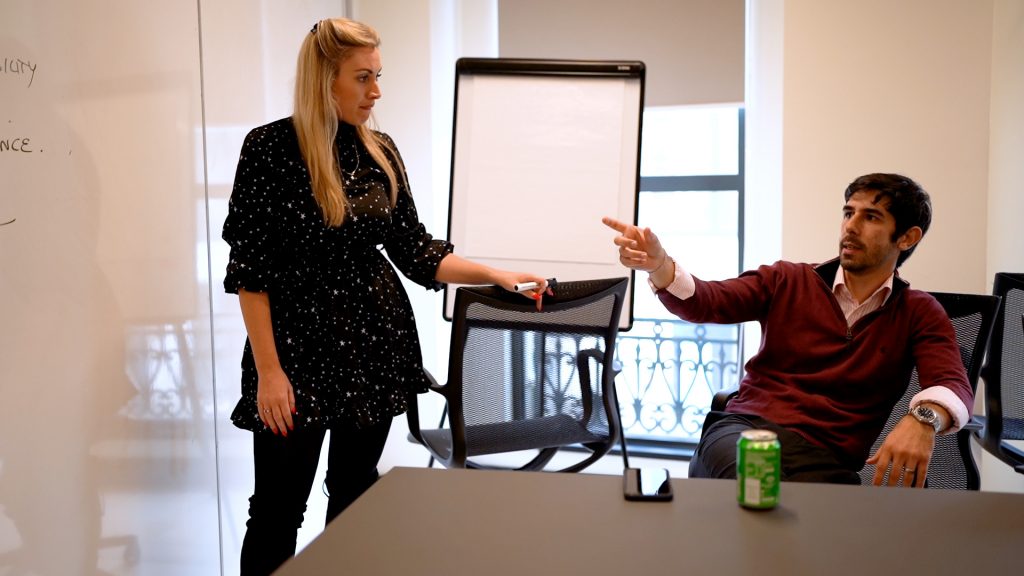By: Jacqueline Shakespeare
Tell me a story..
Four simple words that evoke so many memories and emotions.
Humans are natural storytellers, we can’t help telling stories. They are fundamental to our existence and my childhood was enriched by them.
Enchanting, imaginary tales from my father about a field mouse and turtle who were the very best of friends and gritty stories of wartime from my grandfather. My grandmother shared anecdotes of the people she had grown up with in Scotland. Charming, colourful characters, the memories of whom made her laugh as she told me the stories many years later.
I now read stories to my children and their desire for them is insatiable. They beg me to ‘just finish the page, please, please’ and then as I do, will beg me for ‘just one more’. When our reading time eventually does end, they will immediately turn and pick up their own book, to lose themselves in a different world of adventure.

But how can effective storytelling help us in the workplace?
We consume enormous amounts of data every day through emails, instant messaging groups, documents, conference calls, newspapers, social networking sites, the list goes on. Our brains are constantly having to work out what is useful and necessary and what it can let go of.
To be heard at work, we need to be original and compelling.
Facts and figures alone don’t stick in our minds, but stories create ‘sticky’ memories by attaching emotions to the rational information in front of us. Leaders who create and share strong stories have a powerful advantage.
When we tell effective stories, we give the listener context and help them organise a mass of data into a form that is compelling and engaging. We create something that is memorable, repeatable and credible. It helps us to build a trusted relationship with the people we share our stories with.
So how can we develop our stories at work? The following principles will help you create your own engaging story.

6 steps to tell stories with impact
-
Include Context
To make sense of all of your information, people need to understand how everything fits together, the journey that you have been on so far and your current thinking. They will also benefit from a clearly articulated vision of where you are heading.
-
Add drama
When we experience an emotionally charged event, dopamine is released, making the story easy to remember. The brain is highly attracted to stories that involve a challenge with the promise of triumph in the end. Injecting drama into your story will help to drive belief in the need for change.
-
Make it personal
This will help individuals see the importance of their role in your journey and will give them a sense of purpose. People will come together through the shared experience you are offering them, making each individual feel part of something bigger. Ultimately, the more people identify with a story, the more open they are to being persuaded.
-
Be open and honest
Recognisable truth builds trust in the storyteller and credibility of the data being shared. People won’t believe an over-polished story, it will fail to engage your listeners.
-
Keep it simple
Simple stories are strong stories and the ones that captivate us the most. Remove any content in your stories that doesn’t contribute directly to the narrative.
-
Embrace all learning preferences
Use visuals alongside the written word. Research has shown that the human brain processes images sixty times faster than words and that we remember visual images much easier and better than words. Narrate the story for your listener and, where possible, be physically together.

How Storytelling made a CIO More Engaged in the Workplace
A while ago, I was working on an agile transformation in a UK based organisation. One day, the CIO called me into his office and said simply, ’I need your help’. It transpired that he was under pressure from the organisation’s global parent company to confirm the business case supporting a new programme of work. He had to submit this business case by the first of the following month, just three weeks away.
The programme ambition was to move to a product centric operating model which enabled faster and more frequent delivery, more effectively, whilst maintaining quality. This required transformational change to adopt the values, practices and tools for product development based on agility and DevOps.
A team of experts were helping the organisation to scope out the work. They had, in their view, comprehensively designed the ideal future state architecture and detailed the supporting costs. They were therefore surprised when they took all of the data and information to the CIO that he felt it lacked credibility.
The CIO couldn’t confirm the business case to the organisation’s parent company because he didn’t believe it, and the programme team were unable to progress without the support of the CIO.
The CIO tried to explain he didn’t understand where the numbers came from. The team of experts gave him more data, believing that was what he was asking for, but he wasn’t. The transformation stalled.
I recognised that he was asking for a story. Simply having all the data, information, processes and practical solutions in place hadn’t engaged him. The 500-slide PowerPoint presentation isn’t very helpful anymore..

Our Simple Approach
So, I brought everyone together. The technical experts, the operational technology team, the HR and Finance teams and the Business Lead. A Business Lead that was leading in name only, a reluctant volunteer. It was clear to everyone in the room that he wasn’t engaged.
Over a five-day period, we held a series of workshops and created our story, starting right at the beginning.
How we Embraced all Learning Preferences
For the first two days, we didn’t talk about technology at all. This was difficult and often uncomfortable for the architecture experts in the room. We worked through why we needed to change, we recognised our drama. We articulated our team purpose, vision and planned how we would make it relevant for people.
I started to notice small changes in behaviour showing that people were beginning to engage in the transformation and move away from feeling that change was just ‘being done to them’.
People’s language became more inclusive, there were no more crossed arms and people were physically moving around the rom so that they were closer to the work. The Business Lead voluntarily began to stand up to lead sections of the workshop. Whenever one of our key stakeholders dropped in (there was an open invitation to all of them), he was keen to be the one to share our progress and explain the new developments and thinking. Ownership for the change was starting to sit firmly with the Business Lead.
Finally, everyone understood why change was needed and was engaged in the ambition of the programme.
We Were Open and Honest
On day three we started to look at the technology. We developed the future state architecture, understood what capabilities we needed and how we needed to structure the teams to deliver it all. Finally, we could start to build the cost model.
All the way through the process, I quietly kept stakeholders informed of our progress. I sent informal emails, the odd picture of people white boarding the future state infrastructure, all to build confidence in the work we were doing and to warm them up to the end story. Being open and honest turned out to be a big factor to success.
At the end of the five days, the team were exhausted but excited by the story that they had developed. All through the workshops we had been building the narrative, all of the thinking and detail had been captured, using words and visuals. When we left the workshop, the Business Lead had the completed story, ready to share with his stakeholders.
The Result
The Business Lead went to see the CIO. The CIO heard the story that he had been looking for, one that he felt was credible. The facts and data were still present, but the Business Lead’s passion, ideas and opinions added perspective and believability. The CIO found the story persuasive, he engaged with the transformation and, finally, he could confirm the business case with the organisation’s parent company and the team could move ahead with the transformation.
The Business Lead told the story over and over again, across the organisation, to many different teams and individuals. The narrative was consistent and simple and therefore recognised and remembered.
He was no longer a reluctant volunteer, but an energised and engaged leader. The transformation was delivered successfully and he has continued to tell stories ever since to engage and lead his teams through change. He understands that adults need stories as much as children do.

When you develop stories remember –
- Be consistent in your messaging and repeat often.
- Look at the problem through the eyes of your stakeholders rather than being driven by what you want to say.
- Remember that people are far more motivated by their organisation’s transcendent purpose (how it improves lives) than by its transactional purpose (how it sells goods and services).
- Sharing personal stories makes you feel vulnerable, but it’s that vulnerability that resonates with and connects you to other people.
- Flaws make stories interesting, more believable and more relatable. Never worry about creating the perfect narrative, just tell your story.
- Tell your stories with unflinching honesty, your listener will know if your story is genuine.
- Choose your storyteller well. The person who created the story isn’t always the best narrator. Our feelings towards a storyteller influence our reaction to their story.
WANT TO KNOW MORE ABOUT HOW S&S CAN HELP YOU AND YOUR ORGANISATION?
- Sign up for our fortnightly newsletter The Pulse with cutting edge business insights from our experts.
- If you’re a senior leader or change agent, join one of our change communities to network and share with like-minded individuals.
- If you have a problem that needs solving across business change, agility, leadership or transformation and you don’t want to go down the big, traditional consulting route. Get in touch





































































